US Immigration and Customs Enforcement: History, Role, and Impact
VerifiedAdded on 2023/06/08
|6
|1293
|196
Essay
AI Summary
This essay provides an overview of the United States Immigration and Customs Enforcement (ICE), a federal law enforcement agency established in 2003 under the Department of Homeland Security. It discusses the agency's formation in response to the September 11, 2001 terrorist attacks, its initial mission to improve efficiency in detecting suspected terrorists, and its subsequent transformation under different presidential administrations. The essay highlights the shift in focus from undocumented immigrants who committed serious crimes under the Obama administration to a broader mandate targeting anyone believed to be in the country illegally under the Trump administration. It also addresses the controversies surrounding ICE, including concerns about its effectiveness, the separation of families, and allegations of rogue behavior by its agents, while also noting the agency's perceived role in preventing crime. The essay references various sources to support its analysis of ICE's history, role, and impact.
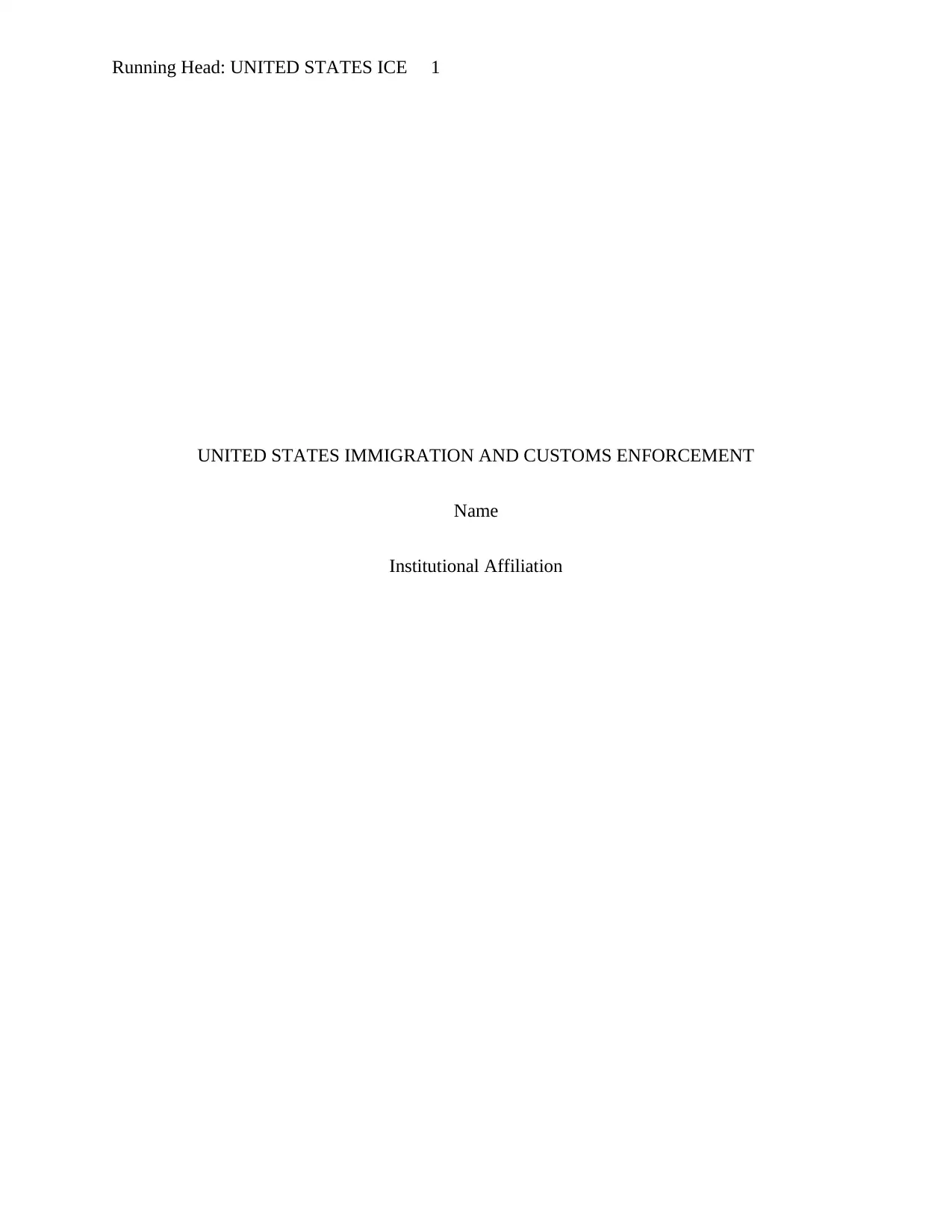
Running Head: UNITED STATES ICE 1
UNITED STATES IMMIGRATION AND CUSTOMS ENFORCEMENT
Name
Institutional Affiliation
UNITED STATES IMMIGRATION AND CUSTOMS ENFORCEMENT
Name
Institutional Affiliation
Paraphrase This Document
Need a fresh take? Get an instant paraphrase of this document with our AI Paraphraser
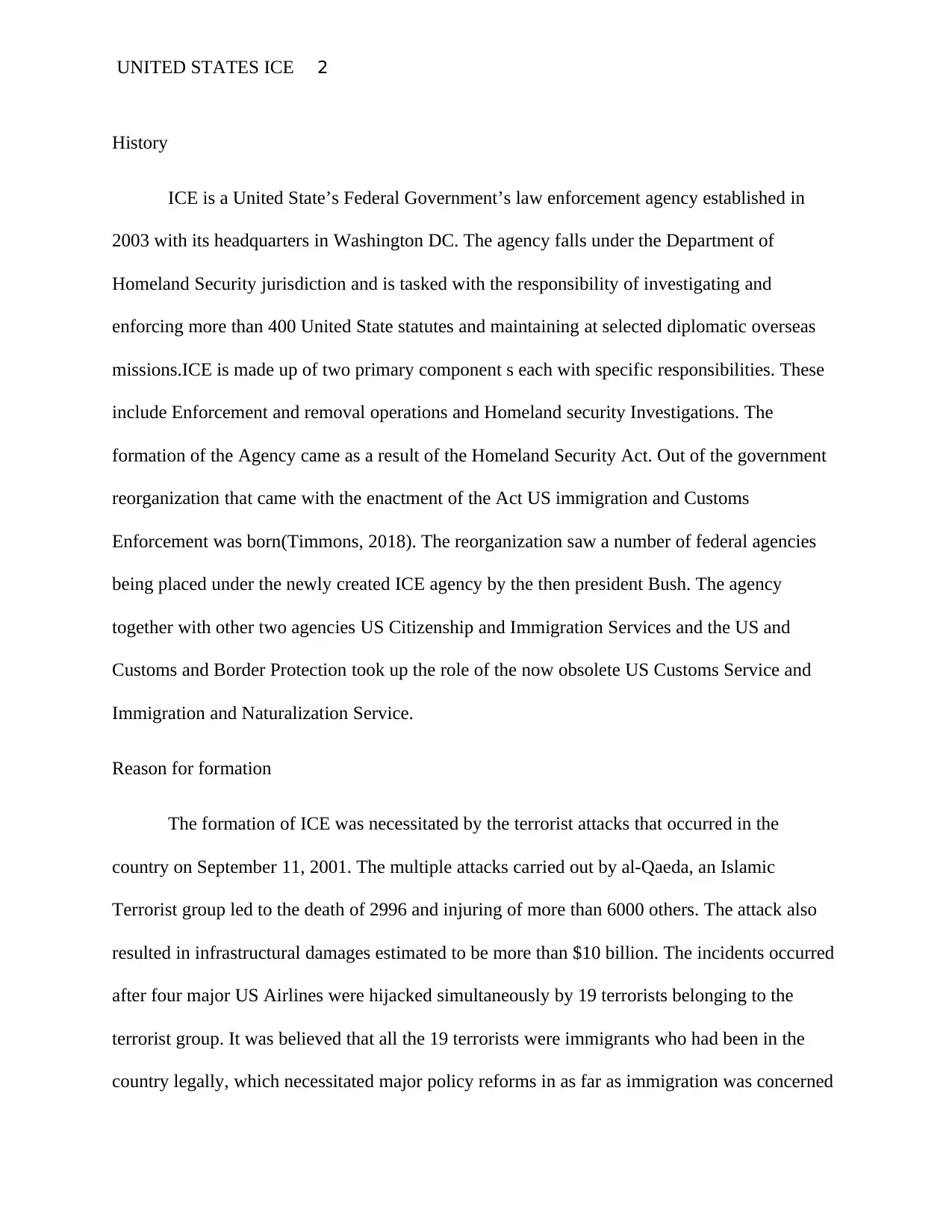
UNITED STATES ICE 2
History
ICE is a United State’s Federal Government’s law enforcement agency established in
2003 with its headquarters in Washington DC. The agency falls under the Department of
Homeland Security jurisdiction and is tasked with the responsibility of investigating and
enforcing more than 400 United State statutes and maintaining at selected diplomatic overseas
missions.ICE is made up of two primary component s each with specific responsibilities. These
include Enforcement and removal operations and Homeland security Investigations. The
formation of the Agency came as a result of the Homeland Security Act. Out of the government
reorganization that came with the enactment of the Act US immigration and Customs
Enforcement was born(Timmons, 2018). The reorganization saw a number of federal agencies
being placed under the newly created ICE agency by the then president Bush. The agency
together with other two agencies US Citizenship and Immigration Services and the US and
Customs and Border Protection took up the role of the now obsolete US Customs Service and
Immigration and Naturalization Service.
Reason for formation
The formation of ICE was necessitated by the terrorist attacks that occurred in the
country on September 11, 2001. The multiple attacks carried out by al-Qaeda, an Islamic
Terrorist group led to the death of 2996 and injuring of more than 6000 others. The attack also
resulted in infrastructural damages estimated to be more than $10 billion. The incidents occurred
after four major US Airlines were hijacked simultaneously by 19 terrorists belonging to the
terrorist group. It was believed that all the 19 terrorists were immigrants who had been in the
country legally, which necessitated major policy reforms in as far as immigration was concerned
History
ICE is a United State’s Federal Government’s law enforcement agency established in
2003 with its headquarters in Washington DC. The agency falls under the Department of
Homeland Security jurisdiction and is tasked with the responsibility of investigating and
enforcing more than 400 United State statutes and maintaining at selected diplomatic overseas
missions.ICE is made up of two primary component s each with specific responsibilities. These
include Enforcement and removal operations and Homeland security Investigations. The
formation of the Agency came as a result of the Homeland Security Act. Out of the government
reorganization that came with the enactment of the Act US immigration and Customs
Enforcement was born(Timmons, 2018). The reorganization saw a number of federal agencies
being placed under the newly created ICE agency by the then president Bush. The agency
together with other two agencies US Citizenship and Immigration Services and the US and
Customs and Border Protection took up the role of the now obsolete US Customs Service and
Immigration and Naturalization Service.
Reason for formation
The formation of ICE was necessitated by the terrorist attacks that occurred in the
country on September 11, 2001. The multiple attacks carried out by al-Qaeda, an Islamic
Terrorist group led to the death of 2996 and injuring of more than 6000 others. The attack also
resulted in infrastructural damages estimated to be more than $10 billion. The incidents occurred
after four major US Airlines were hijacked simultaneously by 19 terrorists belonging to the
terrorist group. It was believed that all the 19 terrorists were immigrants who had been in the
country legally, which necessitated major policy reforms in as far as immigration was concerned
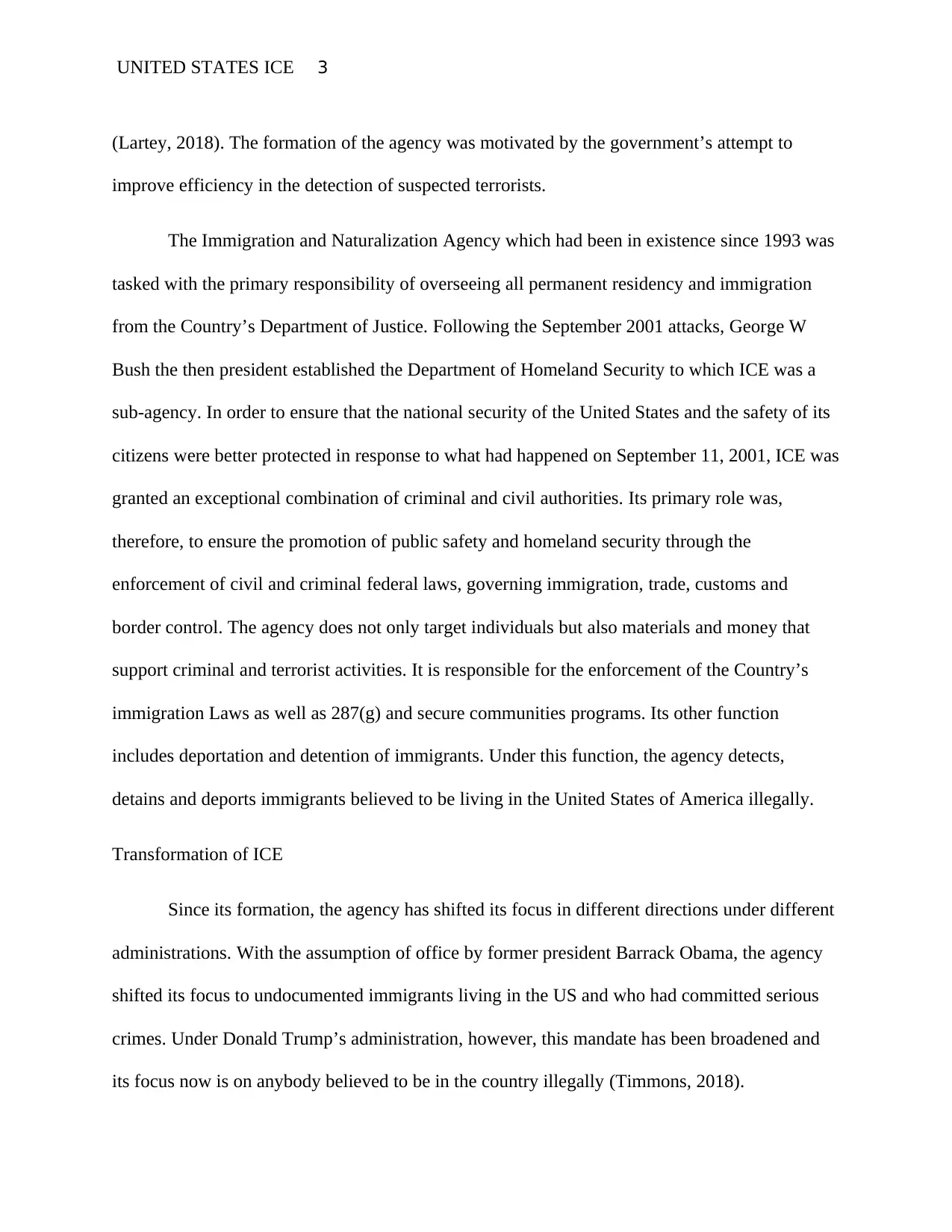
UNITED STATES ICE 3
(Lartey, 2018). The formation of the agency was motivated by the government’s attempt to
improve efficiency in the detection of suspected terrorists.
The Immigration and Naturalization Agency which had been in existence since 1993 was
tasked with the primary responsibility of overseeing all permanent residency and immigration
from the Country’s Department of Justice. Following the September 2001 attacks, George W
Bush the then president established the Department of Homeland Security to which ICE was a
sub-agency. In order to ensure that the national security of the United States and the safety of its
citizens were better protected in response to what had happened on September 11, 2001, ICE was
granted an exceptional combination of criminal and civil authorities. Its primary role was,
therefore, to ensure the promotion of public safety and homeland security through the
enforcement of civil and criminal federal laws, governing immigration, trade, customs and
border control. The agency does not only target individuals but also materials and money that
support criminal and terrorist activities. It is responsible for the enforcement of the Country’s
immigration Laws as well as 287(g) and secure communities programs. Its other function
includes deportation and detention of immigrants. Under this function, the agency detects,
detains and deports immigrants believed to be living in the United States of America illegally.
Transformation of ICE
Since its formation, the agency has shifted its focus in different directions under different
administrations. With the assumption of office by former president Barrack Obama, the agency
shifted its focus to undocumented immigrants living in the US and who had committed serious
crimes. Under Donald Trump’s administration, however, this mandate has been broadened and
its focus now is on anybody believed to be in the country illegally (Timmons, 2018).
(Lartey, 2018). The formation of the agency was motivated by the government’s attempt to
improve efficiency in the detection of suspected terrorists.
The Immigration and Naturalization Agency which had been in existence since 1993 was
tasked with the primary responsibility of overseeing all permanent residency and immigration
from the Country’s Department of Justice. Following the September 2001 attacks, George W
Bush the then president established the Department of Homeland Security to which ICE was a
sub-agency. In order to ensure that the national security of the United States and the safety of its
citizens were better protected in response to what had happened on September 11, 2001, ICE was
granted an exceptional combination of criminal and civil authorities. Its primary role was,
therefore, to ensure the promotion of public safety and homeland security through the
enforcement of civil and criminal federal laws, governing immigration, trade, customs and
border control. The agency does not only target individuals but also materials and money that
support criminal and terrorist activities. It is responsible for the enforcement of the Country’s
immigration Laws as well as 287(g) and secure communities programs. Its other function
includes deportation and detention of immigrants. Under this function, the agency detects,
detains and deports immigrants believed to be living in the United States of America illegally.
Transformation of ICE
Since its formation, the agency has shifted its focus in different directions under different
administrations. With the assumption of office by former president Barrack Obama, the agency
shifted its focus to undocumented immigrants living in the US and who had committed serious
crimes. Under Donald Trump’s administration, however, this mandate has been broadened and
its focus now is on anybody believed to be in the country illegally (Timmons, 2018).
⊘ This is a preview!⊘
Do you want full access?
Subscribe today to unlock all pages.

Trusted by 1+ million students worldwide
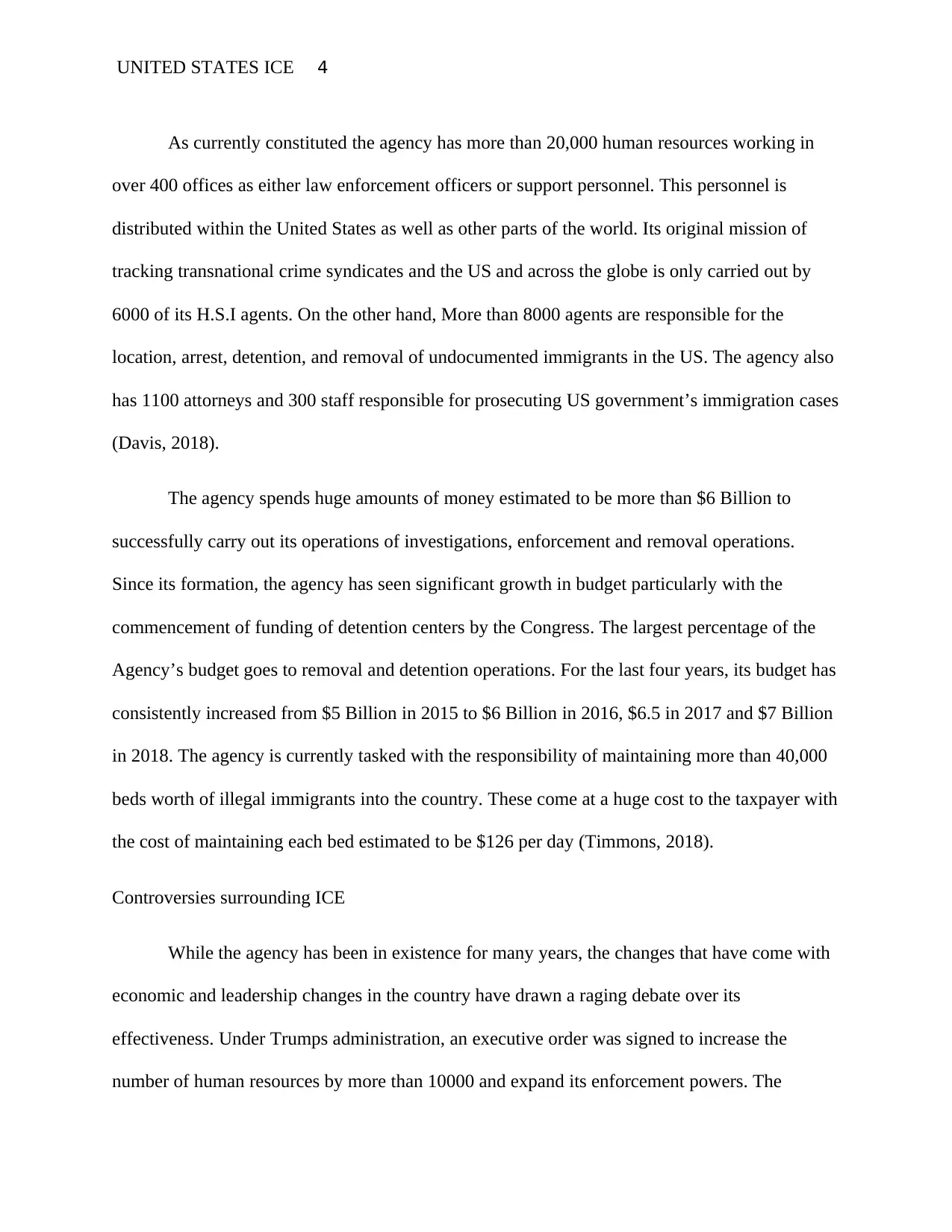
UNITED STATES ICE 4
As currently constituted the agency has more than 20,000 human resources working in
over 400 offices as either law enforcement officers or support personnel. This personnel is
distributed within the United States as well as other parts of the world. Its original mission of
tracking transnational crime syndicates and the US and across the globe is only carried out by
6000 of its H.S.I agents. On the other hand, More than 8000 agents are responsible for the
location, arrest, detention, and removal of undocumented immigrants in the US. The agency also
has 1100 attorneys and 300 staff responsible for prosecuting US government’s immigration cases
(Davis, 2018).
The agency spends huge amounts of money estimated to be more than $6 Billion to
successfully carry out its operations of investigations, enforcement and removal operations.
Since its formation, the agency has seen significant growth in budget particularly with the
commencement of funding of detention centers by the Congress. The largest percentage of the
Agency’s budget goes to removal and detention operations. For the last four years, its budget has
consistently increased from $5 Billion in 2015 to $6 Billion in 2016, $6.5 in 2017 and $7 Billion
in 2018. The agency is currently tasked with the responsibility of maintaining more than 40,000
beds worth of illegal immigrants into the country. These come at a huge cost to the taxpayer with
the cost of maintaining each bed estimated to be $126 per day (Timmons, 2018).
Controversies surrounding ICE
While the agency has been in existence for many years, the changes that have come with
economic and leadership changes in the country have drawn a raging debate over its
effectiveness. Under Trumps administration, an executive order was signed to increase the
number of human resources by more than 10000 and expand its enforcement powers. The
As currently constituted the agency has more than 20,000 human resources working in
over 400 offices as either law enforcement officers or support personnel. This personnel is
distributed within the United States as well as other parts of the world. Its original mission of
tracking transnational crime syndicates and the US and across the globe is only carried out by
6000 of its H.S.I agents. On the other hand, More than 8000 agents are responsible for the
location, arrest, detention, and removal of undocumented immigrants in the US. The agency also
has 1100 attorneys and 300 staff responsible for prosecuting US government’s immigration cases
(Davis, 2018).
The agency spends huge amounts of money estimated to be more than $6 Billion to
successfully carry out its operations of investigations, enforcement and removal operations.
Since its formation, the agency has seen significant growth in budget particularly with the
commencement of funding of detention centers by the Congress. The largest percentage of the
Agency’s budget goes to removal and detention operations. For the last four years, its budget has
consistently increased from $5 Billion in 2015 to $6 Billion in 2016, $6.5 in 2017 and $7 Billion
in 2018. The agency is currently tasked with the responsibility of maintaining more than 40,000
beds worth of illegal immigrants into the country. These come at a huge cost to the taxpayer with
the cost of maintaining each bed estimated to be $126 per day (Timmons, 2018).
Controversies surrounding ICE
While the agency has been in existence for many years, the changes that have come with
economic and leadership changes in the country have drawn a raging debate over its
effectiveness. Under Trumps administration, an executive order was signed to increase the
number of human resources by more than 10000 and expand its enforcement powers. The
Paraphrase This Document
Need a fresh take? Get an instant paraphrase of this document with our AI Paraphraser
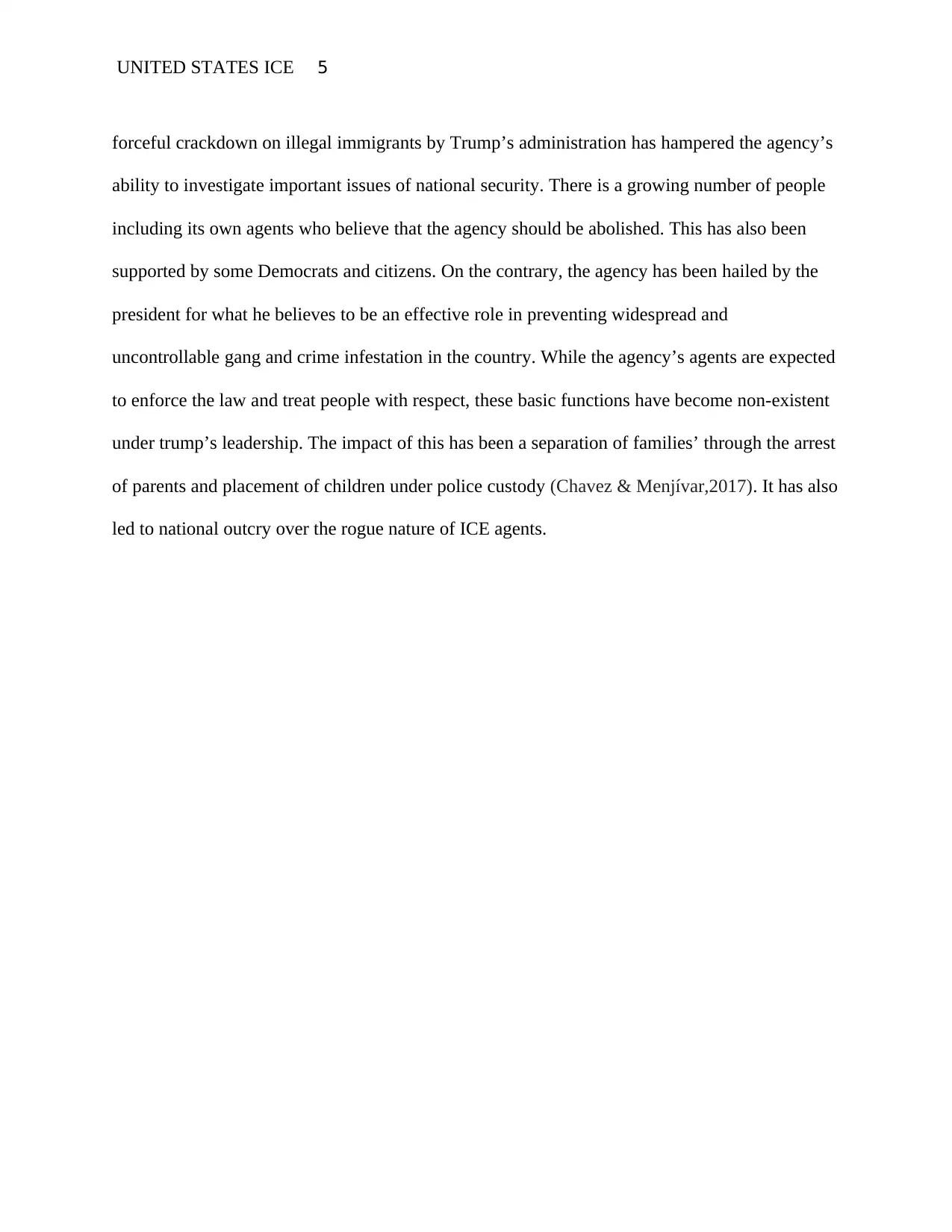
UNITED STATES ICE 5
forceful crackdown on illegal immigrants by Trump’s administration has hampered the agency’s
ability to investigate important issues of national security. There is a growing number of people
including its own agents who believe that the agency should be abolished. This has also been
supported by some Democrats and citizens. On the contrary, the agency has been hailed by the
president for what he believes to be an effective role in preventing widespread and
uncontrollable gang and crime infestation in the country. While the agency’s agents are expected
to enforce the law and treat people with respect, these basic functions have become non-existent
under trump’s leadership. The impact of this has been a separation of families’ through the arrest
of parents and placement of children under police custody (Chavez & Menjívar,2017). It has also
led to national outcry over the rogue nature of ICE agents.
forceful crackdown on illegal immigrants by Trump’s administration has hampered the agency’s
ability to investigate important issues of national security. There is a growing number of people
including its own agents who believe that the agency should be abolished. This has also been
supported by some Democrats and citizens. On the contrary, the agency has been hailed by the
president for what he believes to be an effective role in preventing widespread and
uncontrollable gang and crime infestation in the country. While the agency’s agents are expected
to enforce the law and treat people with respect, these basic functions have become non-existent
under trump’s leadership. The impact of this has been a separation of families’ through the arrest
of parents and placement of children under police custody (Chavez & Menjívar,2017). It has also
led to national outcry over the rogue nature of ICE agents.
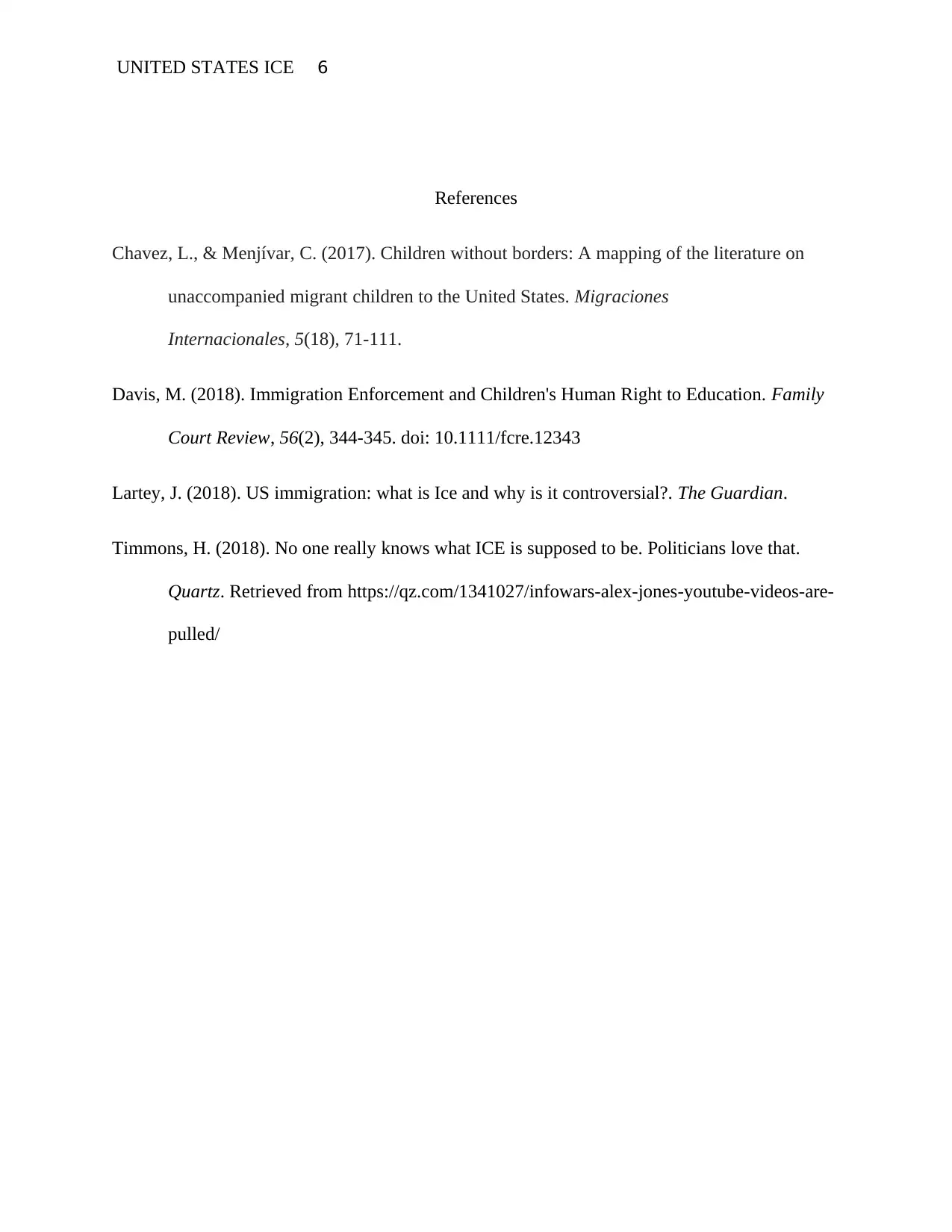
UNITED STATES ICE 6
References
Chavez, L., & Menjívar, C. (2017). Children without borders: A mapping of the literature on
unaccompanied migrant children to the United States. Migraciones
Internacionales, 5(18), 71-111.
Davis, M. (2018). Immigration Enforcement and Children's Human Right to Education. Family
Court Review, 56(2), 344-345. doi: 10.1111/fcre.12343
Lartey, J. (2018). US immigration: what is Ice and why is it controversial?. The Guardian.
Timmons, H. (2018). No one really knows what ICE is supposed to be. Politicians love that.
Quartz. Retrieved from https://qz.com/1341027/infowars-alex-jones-youtube-videos-are-
pulled/
References
Chavez, L., & Menjívar, C. (2017). Children without borders: A mapping of the literature on
unaccompanied migrant children to the United States. Migraciones
Internacionales, 5(18), 71-111.
Davis, M. (2018). Immigration Enforcement and Children's Human Right to Education. Family
Court Review, 56(2), 344-345. doi: 10.1111/fcre.12343
Lartey, J. (2018). US immigration: what is Ice and why is it controversial?. The Guardian.
Timmons, H. (2018). No one really knows what ICE is supposed to be. Politicians love that.
Quartz. Retrieved from https://qz.com/1341027/infowars-alex-jones-youtube-videos-are-
pulled/
⊘ This is a preview!⊘
Do you want full access?
Subscribe today to unlock all pages.

Trusted by 1+ million students worldwide
1 out of 6
Related Documents
Your All-in-One AI-Powered Toolkit for Academic Success.
+13062052269
info@desklib.com
Available 24*7 on WhatsApp / Email
![[object Object]](/_next/static/media/star-bottom.7253800d.svg)
Unlock your academic potential
Copyright © 2020–2025 A2Z Services. All Rights Reserved. Developed and managed by ZUCOL.





